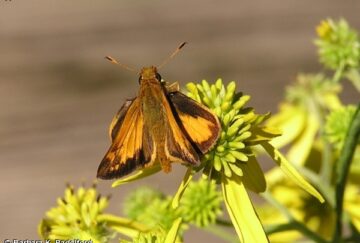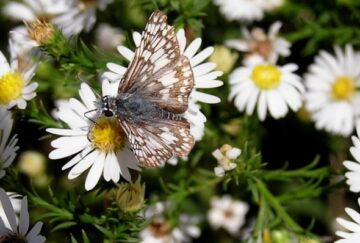Skippers
Skippers, in the family Hesperiidae, make up a large group worldwide of mostly small, difficult to identify butterflies. There are about 250 species in North America. They differ from other butterflies in the shape of their antennal clubs (which are bent with a narrow extension) and details of the wing veins. Most skippers have heavy bodies, squarish heads and large eyes. Most are fast fliers. The larvae are seldom seen because they spend the day in leaf shelters and come out at night to feed. Most of the larvae can be recognized by their narrow necks and enlarged heads.
The Spread-wing Skippers (subfamily Pyrginae) include many species that sit with their wings spread open. However, some like the Cloudywings usually sit with the wings partially open. Some are brightly colored, but most are patterned in brown, black and white. The larvae feed on legumes, mallows, oaks and others.
The Grass Skippers (Hesperiinae) are mostly small and challenging to identify. They are orange, yellow or brown with white or black markings depending on the species. When basking, they hold their hindwings and forewings at different angles, suggesting the appearance of the swept-back wings of a delta-winged fighter plane. This allows the simultaneous viewing of the dorsal hindwing and dorsal forewing on the opposite sides of the butterfly. Males of many grass skippers have a black patch of scent scales (the stigma) on the dorsal side of the forewing. The larvae of most species feed on grasses and sedges.
Disclaimer: The content of NatureSearch is provided by dedicated volunteer Naturalists of Fontenelle Forest who strive to provide the most accurate information available. Contributors of the images retain their copyrights. The point of contact for this page is: Babs Padelford.


